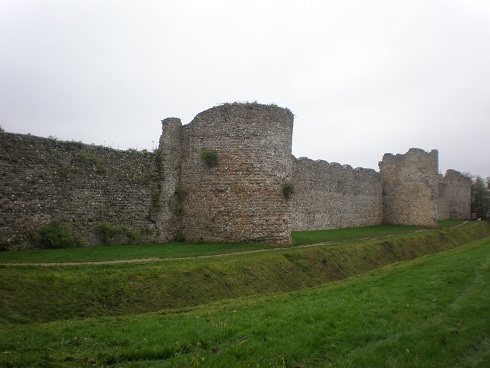By Tim Lambert
Roman Portchester
Portchester is, of course, famous for its castle. It began when the Romans built a fort in the late 3rd century (the exact date is unknown). At that time fierce Saxons from Germany were attacking Eastern and Southern England and the Romans built a chain of coastal forts to stop them. It is possible that civilians were living within the walls. It may have been a trading settlement as well as a fort.
However, in the 4th century Roman civilisation broke down. The last Roman soldiers left Britain in 407 AD. The Roman fort was probably abandoned sometime before the end of Roman rule.
Portchester in the Middle Ages
After the Romans left the Saxons invaded England. About 500 AD they landed in South-East Hampshire and conquered the area. The Saxons gave Portchester its name. They called any Roman fort a ceaster. They called this one Portus ceaster. Eventually, the name changed to Portchester. The Saxons built a village at Portchester. They also erected some buildings within the old Roman fort.
In the 9th century, King Alfred the Great created a network of forts or fortified settlements across his kingdom to fight the Danes. They were called burhs. In the event of a Danish attack, all the men in each area would gather together in the local burh. Where possible Alfred used old Roman towns or forts. In the 10th century his successor, Edward the Elder, repaired the Roman fort at Portchester and turned it into a burh.
Then about 1120 King Henry I built a castle within the walls of the old Roman fort. The castle stimulated the growth of Portchester as the garrison was a market for the peoples’ goods. In the 13th century, Portchester grew into a tiny town. In 1294 it was given the right to hold a market and an annual fair. (In the Middle Ages fairs were like markets but they were held only once a year and they attracted buyers and sellers from a wide area).
During the Hundred Years War between England and France from the middle of the 14th century to the middle of the 15th century Portchester thrived. However medieval Portchester would seem tiny to us. It probably only had a population of a few hundred.
Around the year 1128, a church was built within the walls of the Roman fort at Portchester. It was dedicated to St Mary. In 1133 King Henry I gave it to some Augustinian monks. They were led by a prior so the church became St Mary’s Priory Church. However, in the mid-12th century, the monks moved on to Southwick.
The invention of gunpowder and cannons made Portchester Castle obsolete. (Although in the 16th century, Henry VIII used the castle as an armory and during the civil war of 1642-1646 parliamentary soldiers stayed there).
Furthermore, Portsmouth Harbour silted up and Portchester ceased to be a viable port. During the 16th and 17th centuries, Portchester declined in importance. The market ceased in the early 17th century. Portchester became a quiet farming settlement.
Cornaway Lane was once just called Corn Way because grain was taken along it to be ground to flour in a mill at Wicor.
However, in the 1660s Britain fought the Dutch, and Portchester Castle was used as a prisoner-of-war camp for Dutch prisoners. During the 18th century, it housed Spanish prisoners. Finally, in the long wars against the French from 1793 to 1814, it housed French prisoners.
Modern Portchester
In the 19th century, there was an industry in Portchester making clay pipes for smoking. It began in 1840 and did not end until the 1930s.
Portchester railway station was built in 1848. However, it did not lead to a growth of the village’s population. During the 19th century, Portchester remained a quiet village and the population rose only slightly.
In 1870 the state began to provide education. Castle Street School was built in 1873. n In contrast to the 19th century, in the 20th century the population of Portchester exploded. It was still less than 1,000 in 1911.
However, after the First World War, it grew rapidly. Newtown was built in 1920-1922 and Portchester Methodist Church was built in 1933.
Portchester continued to grow rapidly after the Second World War. Cornaway Estate was built in the 1950s and by 1975 the population had reached 18,000.
The Catholic Church of Our Lady of Walsingham was built in 1954 and Portchester Crematorium opened in 1958.
Wicor Primary School was built, on the present site, in 1962. Northern Primary School opened in 1963 and Red Barn School opened in 1979.
Meanwhile, Portchester Precinct was created in 1975 and a war memorial clock was erected in 1976. A new library opened in Portchester in 1984.
Meanwhile Portchester Community Centre opened in 1966.
Today Portchester is largely a dormitory town, even though Castle Trading Estate was built after World War II. Many of the people who live in Portchester go to work in Portsmouth or Southampton. Meanwhile, Portchester Parish Hall opened in 2002. Portchester Business Centre opened in 2003.

In 2025, the population of Portchester was 18,000.
My Youtube video about the history of Portchester